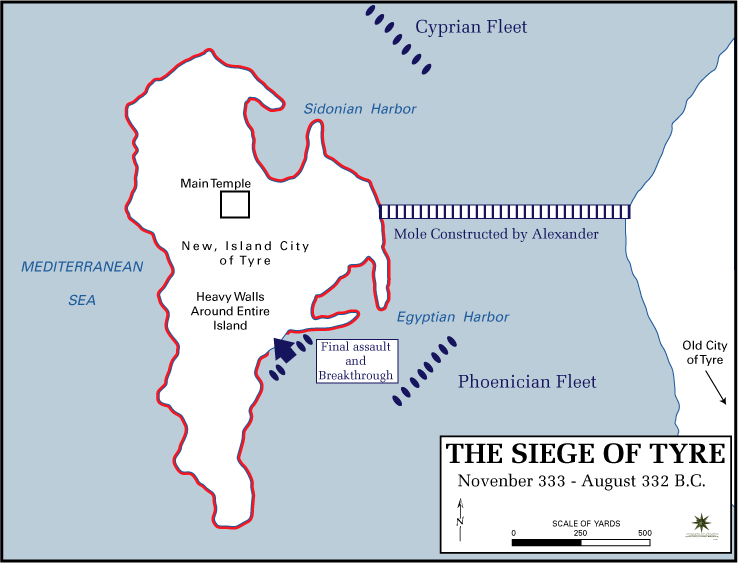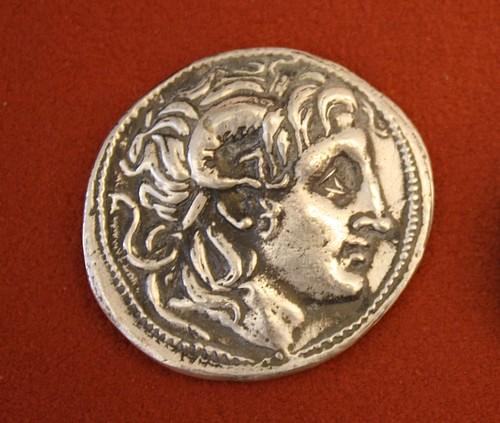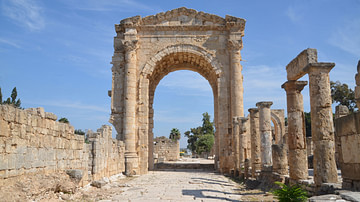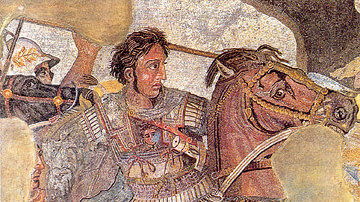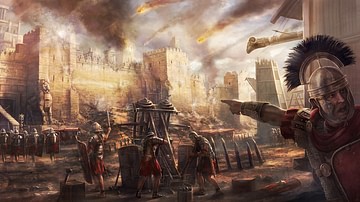After defeating Darius III at the battle of Issus in November 333 BCE, Alexander marched his army (about 35,000-40,000 strong) into Phoenicia, where he received the capitulation of Byblus and Sidon. Tyrian envoys met with Alexander whilst he was on the march, declaring their intent to honour his wishes.
Causes of the Siege
Alexander's request was simple: he wished to sacrifice to Heracles in Tyre. (The Phoenician god Melqart was roughly the equivalent of the Greek Heracles.) The Tyrian's recognised this as a Macedonian ploy to occupy the city and refused, saying instead that Alexander was welcome to sacrifice to Heracles in old Tyre, which was built upon the mainland. Old Tyre held no strategic importance - it was undefended and the Tyrian navy was stationed in the harbours of new Tyre.
The Tyrian refusal to capitulate to Alexander's wishes was tantamount to a declaration of war. But, despite the youthful Alexander's growing reputation, the Tyrians had every reason to be confident. In addition to a powerful navy and mercenary army, their city lay roughly half a mile (0.8 km) offshore, and, according to the account of the historian Arrian, the walls facing the landward side towered to an impressive 150 ft (46m) in height. Whether they actually stood that high is doubtful and open to debate, but even so, the defences of Tyre were formidable and had withstood a number of mighty sieges in the past. The Tyrians began their preparations and evacuated most of the women and children to their colony at Carthage, leaving behind perhaps 40,000 people. Carthage also promised to send more ships and soldiers.
Alexander was aware of Tyre's supposed impregnability and convened a council of war, explaining to his generals the vital importance of securing all Phoenician cities before advancing on Egypt. Tyre was a stronghold for the Persian fleet and could not be left behind to threaten Alexander's rear. In a last-ditch attempt to prevent a long and exhaustive siege, he despatched heralds to Tyre demanding their surrender, but the Macedonian's were executed and their bodies hurled into the sea.
Opening moves of the siege
Negotiations having failed, Alexander began his operations in January 332 BCE. After occupying old Tyre, he began to construct a causeway (or mole) across the channel toward the walls of Tyre, using rocks, timbers, and rubble taken from the buildings of the old city. Initially, work progressed well: the water near the mainland was shallow and the bottom muddy, but, as the causeway lengthened, the Macedonians and Greeks began to run into trouble. The seafloor shelved sharply near the city, to a depth of 18 ft (5.5m). Work slowed to snail-pace, and the work gangs found themselves increasingly harassed by missile fire from the city walls.
Alexander constructed two siege towers from timber covered with rawhide and positioned them at the end of the causeway. Artillery engines at the top of these towers were able to return fire at the walls, and the work gangs erected timber palisades as an added measure of protection. Work proceeded, and Alexander spent much of his time on the mole, dispensing small gifts of money to his sweating labourers and leading by personal example.
The Tyrians then initiated their first major defensive action of the siege. They took an old horse transport ship and filled it to the gunwales with combustible material: chaff, torches, pitch and sulphur. They slung double yardarms from the mast, and to these hooked cauldrons filled with a volatile inflammable oil. The stern of the ship was ballasted to lift the bows clear of the water, and two galleys towed her in towards the end of the mole, driving her and themselves aground.
The crews lit the materials aboard the fireship and all managed to swim to safety. The tip of the mole became an inferno as the ship burnt, igniting the two towers. A host of Tyrians in small boats rowed out from the city and landed on various points of the causeway, engaging the besiegers as they frantically attempted to douse the flames. Siege engines were burnt and the palisades along the edge of the mole destroyed.
Alexander musters his fleet
The attack was a great success for the Tyrians, but they had reckoned without the resolve of Alexander, who now ordered the causeway to be widened and more towers built. Realising that naval superiority was the key to taking Tyre, he temporarily left the siege and set off for Sidon to fetch his own ships. In addition, he also received vessels from Byblus, Aradus, Rhodes, Lycia, Cilicia and Macedon. The Kings of Cyprus sent another 120 ships to Sidon. In all, Alexander now had roughly 220 ships.
Whilst awaiting the arrival of the various naval contingents he spent 10 days inland, engaging in minor operations in Arabian territory. Upon his return to Sidon, he was pleased to note the arrival of Cleander, whom he had sent to Greece to recruit soldiers, with 4,000 mercenaries.
Wasting no further time, Alexander sailed for Tyre. His flagship was on the right of the fleet, and when within clear view of Tyre the fleet halted and held station, allowing the full impact of their appearance to dawn on the observers on the city walls. The Tyrians were taken by surprise: they had no idea until that moment that Alexander's fleet had swollen in size. They were now vastly outnumbered, and the promised help from Carthage had failed to materialise.
Against such odds, a naval engagment was out of the question, and all the Tyrians could do was blockade the entrances to their two harbours. They floated a boom across the mouth of the southern, or Egyptian harbour, and moored Triremes in line across the entrance of the northern (Sidon) harbour.
Alexander tested the strength of these countermeasures with an assault on the Sidon harbour, in which 3 Tyrian galleys were rammed head-on and sunk, but he did not launch an all-out naval attack. Instead, he ordered his Cyprian contingent to blockade the northern harbour, and the Phoenician ships maintained a vigil at the southern end of the island. Siege engines were mounted on the mole, and on anchored ships, and commenced a sustained bombardment of the defences.
Alexander was unable to get his ships close to the city itself because the Tyrians had hurled massive rocks into the sea beneath the walls. The siege now entered what was possibly its most laborious and dangerous phase.
Alexander's ships lassoed some of the boulders and towed them away from the walls. In response, the Tyrians clad some of their galleys in armour plating and sallied out to cut the anchor cables of the besieging ships. Alexander armoured some of his own vessels and used them as a screen in front of his siege ships, but Tyrian divers continued to cut the cables of anchored ships. Alexander finally solved the problem by replacing rope cables with chains. More boulders were lassoed from the causeway and hoisted clear with cranes.
Throughout all of these operations, both sides engaged in a long and bitter artillery duel, and the Tyrians poured cauldrons of red-hot sand over the walls onto the besieging ships. Carried by the wind, it set vessels alight and penetrated clothing and armour, reducing men to charred, blistered agony. Although effective, such methods could hardly have endeared the defenders to the besiegers.
Realising their imminent danger, the Tyrians spread sails across the mouth of the northern harbour, and, thus concealed, prepared a sortie. Thirteen galleys were manned with the finest oarsmen and marines the defenders could muster, and in the heat of the mediterranean afternoon they silently rowed out of the harbour in a single line. Most of the Cyprian ships blockading the Sidon harbour were undermanned and the Tyrians achieved total surprise, pressing home a ferocious assault to the accompaniment of roared warcries. Two Cyprian ships were sunk and many more scattered.
![Greek Hoplites [Artist's Impression]](https://www.worldhistory.org/img/r/p/500x600/4820.png?v=1721188623)
Alexander boarded a ship and personally led the counterattack with 5 Triremes and whatever Quinquiremes were ready for battle. Sailing around the island, he fell on the Tyrian flotilla, who immediately broke off their engagement and fled for the northern harbour. An unspecified number of Tyrian ships were damaged in the confused action which followed, with two galleys being captured at the mouth of the harbour. Most of the Tyrians managed to swim ashore to the safety of the city.
The Final Assault
Alexander now brought his ships directly beneath the walls and began to pound them with battering rams. Greek forces at the northern end of the island attempted to make a breach but failed. A small breach was made in the southern defences but a Macedonian attack across causeways resulted only in casualties and failure.
Alexander waited for three days before resuming his assault. Whilst diversionary attacks occupied the defenders attention, two ships with bridging equipment approached the southern breach. Alexander himself was in command of this force, which consisted mostly of elite hypaspists and pezhaitoroi. The Macedonians managed to force their way onto the wall: Admetus, commander of the Hypaspists, was the first man onto the battlements and was killed by a spear as he exhorted his men onward. Neverthless the assault was a success, and soon the Macedonians were pouring down into the city itself, killing and looting. After this initial breach was forced, Alexanders command was swollen as more and more Greeks and Macedonians succeeded in entering the city from various points, including the harbours.
The surviving Tyrians fell back to the Agenorium, an old fortress in the northern sector of the city, but only managed to hold out for a brief period before they were slaughtered. The besiegers blood was up, and, after a long and bitter siege, they were not inclined to be merciful. For months they had endured grinding labour, been tormented by artillery and archery, and witnessed the slaughter of their captured comrades on the city walls. Six thousand Tyrians were slaughtered when the city was taken, and another 2,000 crucified on the beach. A further 30,000 were sold into slavery. Amongst those spared were the King and his family, and a number of Carthaginian pilgrims who took sanctuary in the Temple of Melqart. Macedonian losses amounted to 400 slain.
With the siege finally over (it had started in January and ended in July), Alexander made his sacrifice to Heracles, and held a torch race and triumphal procession through the streets of the city. With Tyre subjugated, Alexander could turn his attention to subduing Gaza and Egypt.
